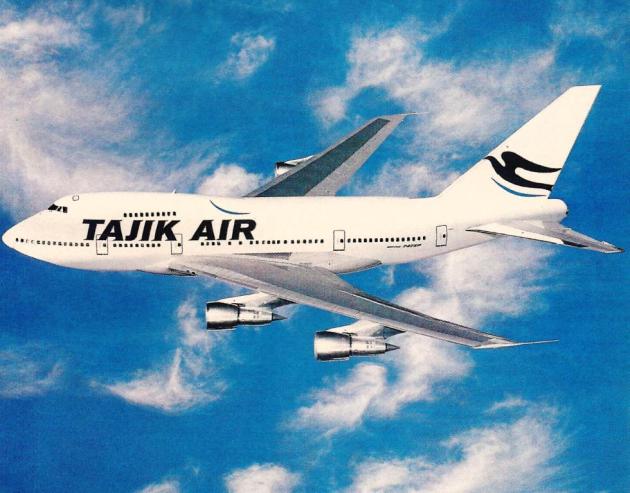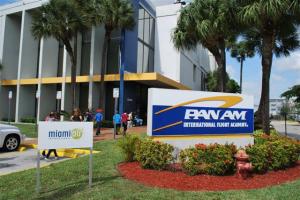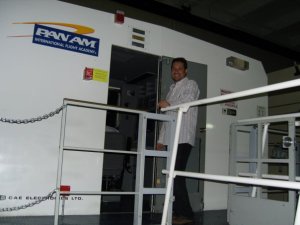The Story of Snow Leopard – Part Two: Crew Training and Acceptance Flight
13 August 2013 2 Comments
Part Two: Crew Training and Acceptance Flight.
Crew Training
The next step in getting Snow Leopard into operation was getting a crew together to fly the Boeing 747SP. Because of the aircraft selection and their availability, it was decided to hire former pilots of Pan American World Airways. The decision was perfectly logical in that Pan Am pilots had many hours of experience in the 747SP – some had actually flown the aircraft when it was with Pan Am – had experience operating in the geographic area of the intended operation, and had the savvy and know-how in dealing with unexpected circumstances or conditions that would be inherent in such an operation.
Captain Sherman Carr, a very experienced Pan Am pilot was one who received a call from a former colleague about an opportunity to be “an aviation pioneer again”. According to Captain Carr, the offer was to operate a new 747 service for the former Soviet Socialist Republic of Tajikistan. He was told the route to be flown and that the pay would be minimal but with generous per diem and off-time. After some research he made his decision. He learned that Tajikistan
“. . .is magnificently beautiful with a major fertile valley with a mild climate that grows cotton surrounded by majestic peaks rising 18 to 20 thousand feet and populated by their national symbol, the snow leopard. I also learned that (the capital) Dushanbe is on the old “Silk Road” route used by Marco Polo when he brought back to Italy, the secrets of making spaghetti from China. The neighboring cities of Tashkent and Samarkand conjured up images of wondrous bazaars and really old world treasures of the Mongol Empire and kabobs made from Yak. I was hooked. Like the line from the Clint Eastwood movie: “do you feel lucky?” I did. I called back and signed up”
It was the same for all the pilots who received “the call”. A chance to be an aviation pioneer was too great an opportunity to turn down.
Once the group was assembled, refresher training was arranged at the Pan Am International Flight Academy in Miami, Florida. The pilots were former Pan Amers and most were over 60 years of age. While that would present a problem in the United States, it did not for Tajikistan. And as is well known, pilots over the age of 60 have a near zero accident rate.
At the academy was a 747SP simulator and the pilots were put through a rigorous training program that brought them up to speed on changes to the aircraft, flight rules and also fined-tuned their instrument piloting skills. At the same time, flight attendants from Tajik Air were undergoing training for the 747SP. These flight attendants were supposedly the “cream of the crop” from Tajik Air but with experience limited to smaller aircraft such as the TU-154 (an old 3-engine aircraft that looked remarkably like at Boeing 727).
While the pilots were progressing well in the refresher training, it was not the case for the flight attendants.
A former Pan Am purser, Gunilla Crawford, was working in contracts at the Pan Am Flight Academy when she received word that the Tajik Air flight attendants were to receive training on the 747SP. Upon their arrival, she immediately discovered a serious problem: their English speaking ability was extremely limited! According to Purser Crawford:
“I had created a training program for the Tajik flight attendants and we started with the 747SP aircraft: the doors, how to arm, disarm, open and close in normal and emergency mode. The first day was spent studying the manual; the second day in the mock- up; the third day back in the classroom. But I soon realized it would take five days to learn the doors and it would take months to teach procedures.
“Nothing I tried worked with the students, mainly because of the language barrier, and partly because of the size of the aircraft. The 747 SP had two aisles vs. the TU-154 single aisle; oxygen masks in the overhead on the747SP vs. two 5” tall oxygen tanks in the aft of the TU-154 cabin, held in place on the floor, standing up! (When we had a delay in Dushanbe, I went onboard and saw the difference.)”
A flight academy employee who spoke Russian eventually acted as an interpreter, but it became painfully clear that this group would not be able to staff a 747SP. Although kind, interested and friendly, they were overwhelmed by the size of the 747SP.
This problem was not only a concern to Purser Crawford, but also to the pilots who were undergoing refresher training at the same time and who had observed the Tajik flight attendants first hand. A solution to the problem was needed, and according to Captain Carr, after meeting with aviation officials from Tajikistan who were present, it was decided to hire some “real” flight attendants from the former Pan Am. Purser Crawford, was in contact with a group of “experienced and adventurous” former cabin crew colleagues, and very soon thereafter, a lot of familiar faces began appearing at the Pan Am Flight Academy.
Training went into full swing for all concerned and soon it was finished. For the cabin crew, it was decided that two or three experienced Pan Am flight attendants would be assigned to each flight. The remaining cabin crew positions would be filled by the Tajik Air flight attendants as “trainees”. The goal, under the supervision and direction of the Pan Am crew, was the Tajik crew to become qualified to “staff and run” a 747SP flight.
However, there was one more thing: Teamwork
From Captain Carr:
“Being on a flight crew is a wonderful thing. It is a team effort. Pan Am had always encouraged working as a team. That teamwork was designed to save lives. Although the duties of the cabin staff are the care and feeding of passengers, their real job is to save lives in an emergency. They operate the emergency equipment and are trained to get people out of the aircraft as quickly as possible. Good communication is essential. As a pilot, I have always appreciated and respected the job the flight attendants do and made sure they knew it”.
In observing the training of the Tajik flight attendants, good communication was non-existent. To alleviate this problem, Captain Carr suggested the Tajiks should see more of America other than their hotel and the flight academy and invited them and his fellow pilots to a luncheon at his home. During the luncheon he made a very important observation:
“[At] almost any cookout in America, guests would pitch in to help with the food and drinks and have a party. Not so with the Tajiks. It became apparent that the concept of initiative did not exist in their culture. They would smile and do anything we asked of them but took no initiative. In an airplane emergency, this can be deadly so we proceeded to see what we could do about it. This was the first chance the pilots and cabin staff had the opportunity to talk in an informal setting. We encouraged them to help themselves and to pass things along to their fellow crewmembers.
“We also started to find out why they didn’t talk to each other. They were all from Tajikistan but some were from various mountain tribes that were at odds with each other. Others were Russian, or Iranian or Tajik valley people. Apparently they had been chosen not because of their good English or flying experience but because they were related to government officials. This was also meant to be a representative group of the Tajik population. While I thought this was a very democratic move, I later learned this diversity was meant to make it less likely that a jealous faction would [cause problems with the operation].
“The lunch went very well and the English phrases, “more beer”, “more vodka” were pronounced much better. I also made arrangements to charter a water taxi for a cruise to see the Bahia Mar Yachting Center and also homes along the waterway. [At the end of the tour] and before returning to Miami, the Tajiks stopped by our home to thank us. Much to my relief they were now all smiling and talking to each other and acting like a flight crew. That lunch was one of the best investments I ever made.”
With the training finished and the Tajiks fresh from their team-building experience, everyone began leaving Miami for London to start the operation. Captain Carr was asked to make the “acceptance flight” of Snow Leopard. He accepted.
Acceptance Flight
The acceptance flight is a critical part of the delivery process of an aircraft to an airline. Once the aircraft is accepted and delivered, anything that is discovered wrong with the aircraft becomes the responsibility of the airline. Inspections and the acceptance flight should ensure that this does not happen. Snow Leopard was flown to London by a United Airlines supervisory pilot and crew. Upon arrival, Captain Carr and his crew met the aircraft and began the task of inspecting the aircraft and its logs and maintenance records and carrying out the acceptance flight. The aircraft looked great with a fresh paint job with Tajik Air livery. Once everything was signed off, and the walk-around inspection complete, the aircraft was pronounced airworthy and Captain Carr and his crew boarded the aircraft to begin the flight.
However, once on board, there was a surprise awaiting them: The aircraft was full of people! Normally such a flight involves the necessary minimum crew members. Not this one. The press was on board, as were Tajik Air officials, the Minister of Aviation of Tajikistan and management staff. In fact station personnel and baggage handlers were also on board!
From Captain Carr:
“[I had] a quiet conversation with the [Minister of Aviation] to make sure that carrying all these people on a test flight was okay. I learned that wonderful Russian phrase: ‘kharasho’ (‘no problem’). Since he was the law for our Tajikistan operating certificate, it was like getting the word directly from God.
“I climbed into my seat in the cockpit. The United pilot looked really nervous and seemed a few shades deeper red than normal. He indicated his concern about all these people on board, and I said ‘kharasho’, took the clip board from him and signed as Pilot in Command. He looked relieved. I reminded him that United was still responsible for any maintenance items until I signed the aircraft acceptance form. The flight went smoothly, the aircraft was perfect and everyone enjoyed the tour of the English countryside as we put the airplane through its paces. We returned to Heathrow and I made my first landing in a real 747 in about a year and a half. As we came in on final approach, I realized that we had almost all the top brass aboard, the new crewmembers and a whole planeload of people who had never been on a 747 before.
“If you’re are flying a 747 correctly, on speed and according to ‘the book’, it normally makes a very nice landing. Once in a while, when conditions are just right and you are very lucky, the touch down is so smooth that you don’t realize you are on the ground until the speedbrake handle comes up as it automatically reacts to a microswitch on the landing gear as the wheels touch ground. This was one of those landings.
“It is a Russian custom to applaud after a landing. But I didn’t think this applause was for landing, rather giving thanks to be alive. However, during the flight we kept the door open for the bigwigs to view the cockpit and after landing I heard the cheers and applause from behind. Winning an Oscar for an actor couldn’t feel any better than how that landing and applause felt to me. As we all left the aircraft my new bosses kept congratulating me as though I was the greatest pilot in the world. What could I say? I just smiled and secretly thanked Boeing.”
Gunilla Crawford, having arrived in London to handle flight service, also had a look at Snow Leopard prior to delivery:
“The day came when we were to see the plane for the first time. It was a rainy overcast day, but there she was as beautiful as ever, sitting on the wet tarmac. We inspected the galleys, the equipment and planned the last details, now that a few months of training and planning had come together and the real adventure was to begin. “Starving” for flying since the demise of Pan Am . . .we were all raring to go, as this would be the “real” thing………..or so we thought.”
It was now time to get ready for operations. Ticket sales and crew scheduling were at the top of the agenda. This and stories about some memorable flights by Snow Leopard will be coming in Part Three of the Story of Snow Leopard.
End of Part Two




I found the story of the Snow Leopard very interesting. I am a former Northwest Airlines Captain who flew the 747-100/200/400 for about 15 years. Northwest never flew the SP but we have other experiences mostly in Asia.
I have a good friend Dan Condon who was Chief Pilot for Pan Am at JFK for many years.
I have told him about your story.
Please send me a link to other Parts of your story.
Ken Hawkins
Thank you very much for your comments on my story. I see you have read Part Two. Part One is on the same blog site (jpbpa2.wordpress.com) and you should be able to access it from there. If you have problems let me know. I have also started a series on Pan Am on the same blog site as well. I’ll be most grateful if you can share this material!
I am currently working on Part Three of Snow Leopard and hope to post it by week’s end. Could you tell me how you found this story?
Thanks again!